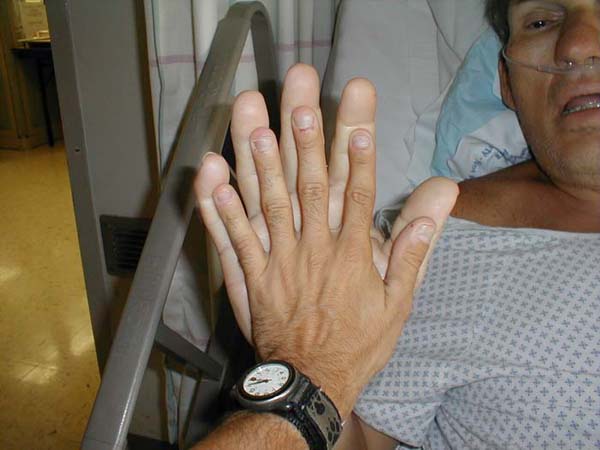Acromegaly history and symptoms: Difference between revisions
No edit summary |
No edit summary |
||
| Line 1: | Line 1: | ||
__NOTOC__ | |||
{{Acromegaly}} | {{Acromegaly}} | ||
{{CMG}} | {{CMG}} | ||
==Symptoms== | ==Overview== | ||
==History and Symptoms== | |||
Features that result from high level of hGH or expanding tumor include: | Features that result from high level of hGH or expanding tumor include: | ||
* Soft tissue swelling of the hands and feet | * Soft tissue swelling of the hands and feet | ||
| Line 30: | Line 32: | ||
</div> | </div> | ||
==Pituitary gigantism in children== | ===Pituitary gigantism in children=== | ||
This condition of growth hormone excess is rare in children and is referred to as [[gigantism|pituitary gigantism]], because the excessive growth hormone produces excessive growth of bones and the child can achieve excessive height. As an affected child becomes an adult, many of the adult problems can gradually develop. The distinction between gigantism (occurring in children) and acromegaly (occurring in adults) can be made by the occurrence of the adenoma in relation to the closure of the [[Bone#Formation|epiphyses]]. If elevated growth hormone levels occur before the closure of the epiphyses (i.e. in prepubertal children), then gigantism ensues. | This condition of growth hormone excess is rare in children and is referred to as [[gigantism|pituitary gigantism]], because the excessive growth hormone produces excessive growth of bones and the child can achieve excessive height. As an affected child becomes an adult, many of the adult problems can gradually develop. The distinction between gigantism (occurring in children) and acromegaly (occurring in adults) can be made by the occurrence of the adenoma in relation to the closure of the [[Bone#Formation|epiphyses]]. If elevated growth hormone levels occur before the closure of the epiphyses (i.e. in prepubertal children), then gigantism ensues. If it occurs after the closure of the epiphyses (i.e., in adults) then acromegaly ensues. | ||
==References== | ==References== | ||
{{reflist|2}} | {{reflist|2}} | ||
{{WikiDoc Help Menu}} | {{WikiDoc Help Menu}} | ||
{{WikiDoc Sources}} | {{WikiDoc Sources}} | ||
Revision as of 19:41, 31 August 2012
|
Acromegaly Microchapters |
|
Diagnosis |
|---|
|
Treatment |
|
Case Studies |
|
Acromegaly history and symptoms On the Web |
|
American Roentgen Ray Society Images of Acromegaly history and symptoms |
|
Risk calculators and risk factors for Acromegaly history and symptoms |
Editor-In-Chief: C. Michael Gibson, M.S., M.D. [1]
Overview
History and Symptoms
Features that result from high level of hGH or expanding tumor include:
- Soft tissue swelling of the hands and feet
- Brow and lower jaw protrusion
- Enlarging hands
- Enlarging feet
- Arthritis and carpal tunnel syndrome
- Teeth spacing increase
- Macroglossia [enlarged tongue]
- Heart failure
- Kidney failure
- Compression of the optic chiasm leading to loss of vision in the outer visual fields (typically bitemporal hemianopia)
- Headache
- Diabetes mellitus
- Hypertension
- Enlarging heart
- Increased palmar sweating and sebum production over the face (seborrhea) are clinical indicators of active growth hormone (GH) producing pituitary tumours. These symptoms can also be used to monitor the activity of the tumour after surgery although biochemical monitoring is confirmatory.
(Image courtesy of Charlie Goldberg, M.D., UCSD School of Medicine and VA Medical Center, San Diego, California)
-
Facial changes secondary to elevated growth hormone levels. Note in particular prominent supra-orbital ridge, jaw, and generally enlarged facial features.
-
Markedly enlarged hand resulting from excess growth hormone. For reference purposes, the comparison hand is size 6 1/2.
-
Facial changes secondary to elevated growth hormone levels. Note in particular prominent supra-orbital ridge, jaw, and generally enlarged facial features.
Pituitary gigantism in children
This condition of growth hormone excess is rare in children and is referred to as pituitary gigantism, because the excessive growth hormone produces excessive growth of bones and the child can achieve excessive height. As an affected child becomes an adult, many of the adult problems can gradually develop. The distinction between gigantism (occurring in children) and acromegaly (occurring in adults) can be made by the occurrence of the adenoma in relation to the closure of the epiphyses. If elevated growth hormone levels occur before the closure of the epiphyses (i.e. in prepubertal children), then gigantism ensues. If it occurs after the closure of the epiphyses (i.e., in adults) then acromegaly ensues.


